Day 6 – We had gotten into our hotel around 8pm the previous night and we were both too tired to even bother going down to the pub for a drink and a little wander. We should have though, as it was pouring down with rain in the morning, with a heavyish fog milling around. The lady in the tourist office even told us not to bother with the Ring of Kerry because it would be fog bound, and we would see nothing.

Ah but she was wrong, the rain was only drizzly and the fog quite minimal when we got there, but it was cold (Mark was lazy and didn’t get out the car much during this bit – so the cold etc had no effect on him). Along the drive we stopped at an old stone ring fort near Sneem, which dates back to around 2,000 BC, so it’s quite amazing it’s still standing. We did end up seeing quite a bit and the overall view from the tip of the peninsula over Derrynane is quite amazing with all the beaches and sweeping green all the way down to them. It would have been good, granted to see across to both the Beara and Dingle peninsulas, but on a holiday in Ireland in unpredictable September, you take the good with the bad.
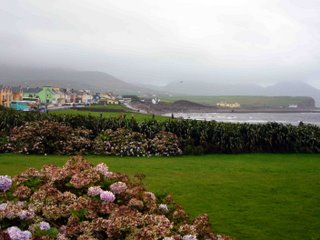
The little town of Waterville on the tip of the ring is very pretty with a proper sandy beach and I can imagine it being supremely appealing on a warm summers day. From there we drove back around and up towards Limerick, via a town called Killorglin where we stopped briefly for lunch (it’s not a very touristy place – we couldn’t even find postcards!!).
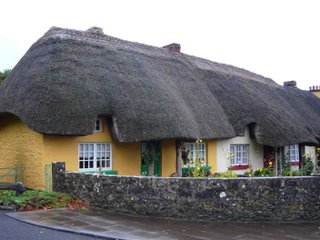
On the way to Limerick we stopped in the very lovely town of Adare, which is quite touristy. This being due to is very English thatched cottages, along with; the Holy Trinity Abbey (founded in 1230 by monks in the Trinitarian Order…something to do with the crusades), a friary dating from 1314 (since restored more recently as a parish church), a Desmond castle from 1326 (which unfortunately was closed for repairs) and a 19th century mansion known as Adare Manor, that now serves as a very posh hotel.
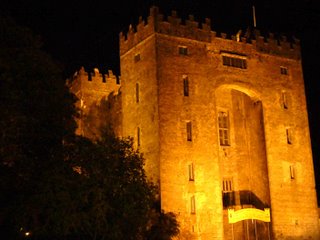
Driving on from there we headed to our final destination for the day, and woo hoo I was allowed to finally drive. It’s very strange after not having driven for 8 months that is for sure. The worst part was I had to drive through peak hour Limerick traffic to get to the town of Bunratty where we were staying for the night. Not terribly amusing, especially since Irish drivers have taken lessons from Adelaide drivers and don’t let people in – very frustrating indeed.
Upon reaching Buntratty we plonked our stuff in our little B&B and headed straight to the local pub, called The Creamery for a dinner of delicious Irish stew in the company of Irish peoples. Ha – the place was full of tourists, German and American. Oh well what can we say after all we were tourists too! Though afterwards we realised that we should have gone to the 2nd pub there called “Dirty Nellys” as being established back in 1620 made its name as the oldest pub in Ireland.
Day 7 – After a delicious breakfast that included pancakes and maple syrup – trust me after having bacon and eggs for the last 6 mornings this was a delight – we headed down the road to Bunratty Casle, a mere 2 minutes from where we were staying. We figured we could get in when it opened and beat the crowds.
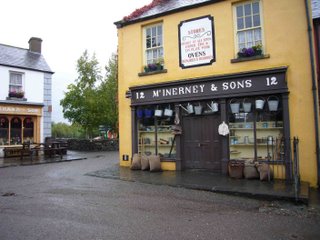
This was the case and we got to explore the castle in all its medieval glory alone (most furniture, paintings and tapestries dated from the 15-16th centuries), whilst it poured with rain outside. Fortunately that cleared away by the time we were back outside and we wandered around the folk park looking at all the replica houses (cottages, village school, blacksmiths, weavers huts, flour mills, and farmyard), which give a somewhat nostalgic view of ye old Ireland.
Lovely but again, as the tourist troops began rolling in, we were ready to be on the move to continue across the breathtaking Cliffs of Moher. Our journey was across the highlands of county Clare, where we were fortunate to pass through some charming little towns and we saw lots of rainbows – no pots of gold thus not a single leprechaun either!
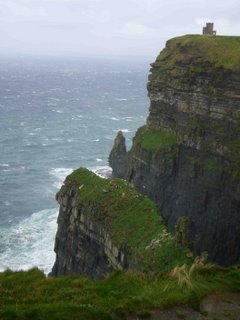
Well the Cliffs were sure windy! Once we managed our way out of the car (an effort when the wind is more than 90 mile an hour and your doors threaten to blow away) and across through the overly crowded tourist trap slash gift/café shop we had to battle said winds, all up hill, to view the magnificent cliffs. It was well worth it though, and being it was relatively clear, we had great views of the cliffs for miles along with the waves crashing heavily up along the coastline.
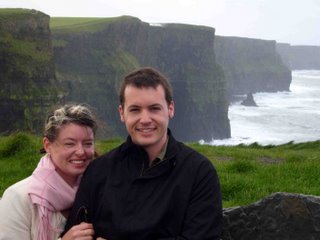
From the cliffs we headed back inland, but not before I made Mark drive along to a stunningly windswept beach for a quick snap, which turned out to be one of my favourite shots. Driving inland was not so windy.
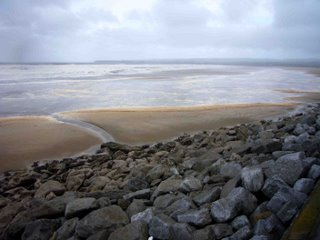 We had a short stop in Kilfenora to visit the Burren Visitor centre as we hoped to learn a bit more about the impressive stone age settlement that we were about to visit.
We had a short stop in Kilfenora to visit the Burren Visitor centre as we hoped to learn a bit more about the impressive stone age settlement that we were about to visit.The area itself is rich in flora despite craggy limestone desolateness and definite lack of trees. It’s also now quite deserted, but as we were soon to see evidence of former human settlement is plentiful in the area.
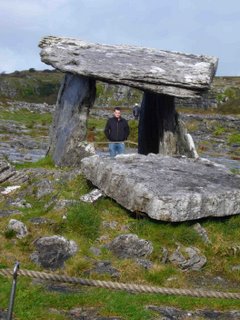
We first stopped to see the Caherconnell stone fort, which may have been established as early as 500AD and there is evidence it was still used in the 15th century. There is really not much to see aside from the outside walls there is not a lot there. We then stopped to see Poulnabrone portal dolmen (circa. 4,000BC), which is a square stone chamber with a huge capstone.
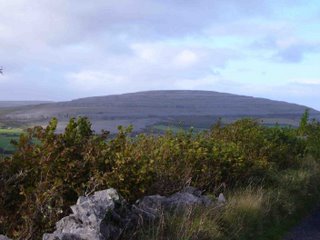
From there we continued our scenic drive (no photos I took here did the scenery any justice – the pinky/purplishness of the rocks simply cannot be portrayed in photos alone) along the R480 heading up towards the picturesque fishing town of Ballyvaughan, which looks across Galway Bay.

Around from there we bypassed Galway to drive straight across and up the N59 through the Connemarra (very west county Galway) towards Leenaun, our final stop for the night. We drove along, yet again, breathtaking scenic roads that took us through the heart of the lonely bog. This was made more impressive with the twin mountain ranges, the Maumturks and the Twelve Bens arising along either side of the road. That and sunset over the mountains was just gorgeous. Oh and we learned afterwards that we apparently took the non-scenic route!!!
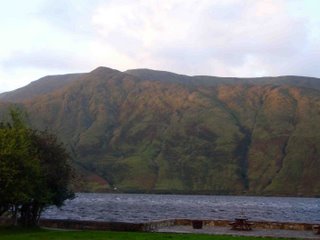
Our destination Leenaun – place of the tides - (or Lenane if you convert it to English) was a tiny village, set on Killary Harbour. This harbour or fjord is known as one of the most beautiful natural harbours in the world. The 200 year old hotel was lovely and the food delicious too. After a good meal and a short trek to the local pub to watch the Leinster verses Munster rugby game, we called it a day.
Day 8 – We had a long day ahead of us so after breakfast we started early with a drive along the more scenic coast roads between Lenane, Letterfrack and Clifden. The area is dotted with lakes and trees line the waters edged, encircling the base of the mountains like ruffles on a skirt. There are sycamore, beech, oak, horse chestnut, conifers and evergreens, along with ferns and Lilly of the valley in more shaded areas. Just looking at the scenery reminded me of paintings seen in art galleries that were now brought to life.

We stopped at Kylemore Abbey, on the Pollacappul Lough near Lettefrack, which was originally built as a grand Gothic country seat in the late 1860’s and grand indeed it was. After WW1 a convent of Belgian nuns purchased it (it was going cheap at 40,000 pounds) and have since restored it to its former glory, including the beautiful abbey, gardens and kitchen gardens. It’s now also a very posh girl’s school – well I wish I went there! This website tells you all about it and has more photos, including from the inside - http://www.kylemoreabbey.com/

Next stop after driving through Letterfrack was Clifden, which officially is the only town in the Connemarra, due to the fact is has a bank, supermarket etc. It’s actually quite up market and costs a fortune to live there, even if it is on the edge of nowhere. We stopped for a wander and had lunch in a nice café, but again we had to keep moving.
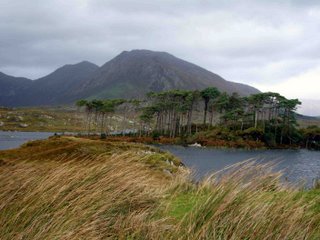
We head back along more scenic roads, along the other side of the Twelve Bens, and we passed some lovely wild Connemarra ponies on our voyage. I got out to take a photo and got quite close without them even stiring (after all they are wild so I wanted to not spook them); however some psycho tourists, who also stopped to take a photo after us, went too close and were far to loud and scared them off. Oh well no decent photo for them.
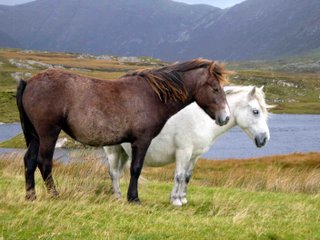
We also passed quite a lot of peat bogs along our way. The peat smells quite strange; especially when it’s burning (they used it at Bunratty Castle). Around that area it is, due to previous geographical and cultural isolations of the past, a Gaeltacht (Irish) speaking region. Thus we had fun reading the road signs! The Connemarra was, for us, a beautiful spot and one that brings to mind images of rugged costs, turf cutting, steep mountains – a haven for poets and artists for sure.

Along the coast road was again scenic, but was not as beautiful as inland Connemarra. So after a long drive, that included; dodging a dog who apparently liked to chase cars (looked a bit like Jed – Marks brothers border collie x), a swag of people doing a fun run near Galway, we got a glimpse of Galway, but alas no time to check out the place. From there we drove pretty much straight 200km across Ireland, briefly stopping for dinner (and we also saw a horse fair…just horses and more than you could count…unbelievable) before ending up back in Dublin by 9pm that night…whew!

Day 9 – Our dodgy hotel, up near Dublin Castle and the Christ Church cathedral, didn’t included breakfast, but by the looks we were lucky for that to be the case, so we ended up going to a cute little crepe place back down near Grafton Street! Yummo. Since it was Sunday (again nothing open till at least noon) we had time to wander around the town, including visit St Patricks cathedral, before we headed to the National Gallery.
At the National Gallery we made an executive decision to view only the 16th century paintings (they had “Lady writing a letter with her maid” by Jan Vermeer, so I had to see that) and the Irish paintings. The reason for that was because the place is massive with over 2,500 paintings and 10,000 other works of art (not all out at once of course).
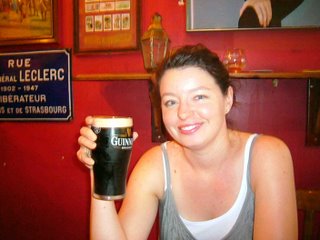
From there we did a bit of window shopping, more wandering and had lunch at an authentic Irish pub called the Hairy Lemon (which included my last pint of Guinness – made in Ireland anyway) before we made our short journey back to Dublin airport for our flight back to sunny London that evening.
No comments:
Post a Comment